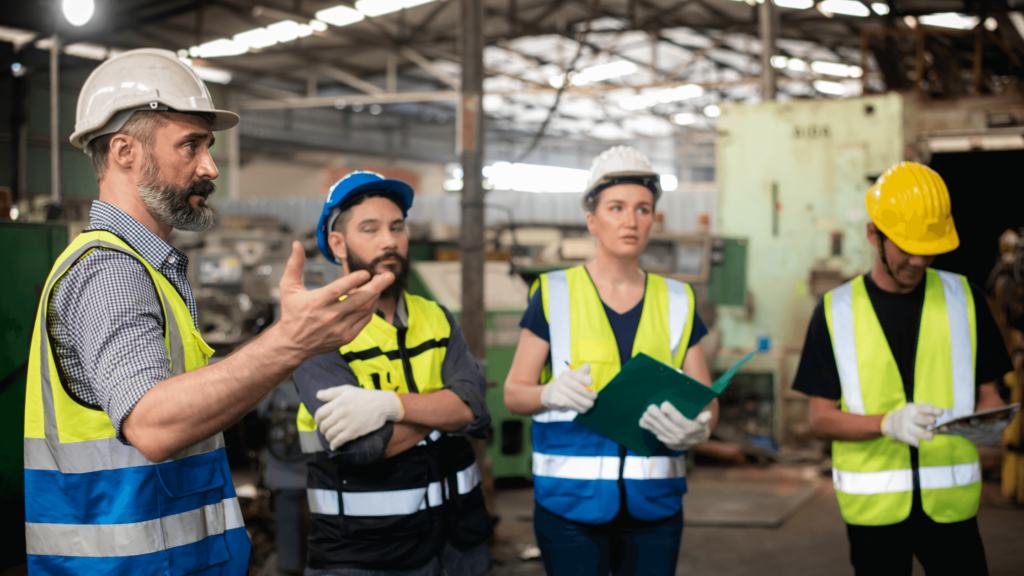The construction industry is rapidly evolving, making upskilling essential for workers and employers. Upskilling improves workforce retention, addresses skills gaps, and enhances productivity on job sites. By equipping teams with the latest knowledge and abilities, companies can stay competitive and better adapt to industry advancements.
Quick look
- Upskilling equips construction workers with modern skills to meet evolving industry demands.
- High turnover, labor shortages, and retirement are key industry challenges upskilling can help solve.
- Upskilling enhances productivity, safety, and retention rates on job sites.
- Strategies like online training, certifications, and peer mentoring support workforce development.
- Investing in upskilling creates a more competitive, resilient construction team.
What is upskilling?

Upskilling refers to the process of equipping workers with new skills or improving existing ones to meet the evolving demands of their jobs. In construction, this includes training workers to use modern technologies, adopt sustainable building practices, and adhere to updated safety protocols. Upskilling is crucial because it helps workers stay competitive in a fast-changing industry while enabling companies to deliver higher-quality projects.
The construction industry has long been rooted in traditional methods, but recent advancements, such as digital tools, automated equipment, and environmentally conscious construction techniques, are reshaping the landscape. Companies that prioritize upskilling not only future-proof their workforce but also attract and retain top talent.
Industry-wide issues
High turnover
The construction sector experiences one of the highest turnover rates across industries. Many workers leave due to a lack of growth opportunities, dissatisfaction with working conditions, or burnout from physically demanding tasks. This high turnover disrupts projects, increases hiring costs, and strains remaining team members. Upskilling provides workers with a clear pathway for career development, boosting job satisfaction and reducing turnover.
Skilled labor shortages
The construction industry is grappling with a significant shortage of skilled workers. A combination of declining interest among younger generations and insufficient training programs has left many job openings unfilled. This gap slows project completion and drives up labor costs. Companies can transform entry-level workers into skilled professionals by investing in upskilling, addressing labor shortages from within.
Retirement of experienced workers
A wave of retirements among experienced construction workers is creating a knowledge gap in the industry. These seasoned professionals take decades of expertise with them, leaving younger workers without mentors. Upskilling programs that involve knowledge transfer and mentorship can help preserve critical skills and ensure continuity.
Technological insufficiency
Adopting advanced construction technologies is critical to staying competitive, but many older workers struggle to adapt to new tools. From BIM (Building Information Modeling) software to drones, modern construction methods require digital literacy. Upskilling ensures that all workers, regardless of age, can effectively use emerging technologies, improving efficiency and project quality.
Safety concerns
The construction industry remains one of the most hazardous fields, with persistent workplace accidents and injuries. Insufficient training and outdated safety practices often contribute to these incidents. Upskilling workers on updated safety protocols and equipment usage can significantly reduce risks and promote a safer working environment.
The power of upskilling your construction team
1. Higher retention rates
When companies invest in their employees’ professional growth, they create a sense of loyalty and belonging among workers. Upskilling provides workers with new opportunities for advancement, which can be especially appealing in an industry where stagnation is common.
Workers are more likely to stay with employers who demonstrate a commitment to their development. Higher retention also reduces recruitment costs and helps maintain project continuity, ensuring smoother operations on job sites. By fostering a culture of learning and development, companies can also attract new talent eager to join an organization that values career growth.
2. More qualified team
Upskilling ensures that construction teams have the necessary expertise to handle complex projects. By equipping workers with specialized skills, such as energy-efficient construction techniques or advanced equipment operation, companies can confidently bid on higher-value projects.
A more qualified team also positively reflects on a company’s reputation, attracting clients who prioritize quality workmanship. As well, a highly skilled team can take on innovative projects and adapt to modern construction trends, giving companies a competitive edge in the marketplace. The cumulative effect of having a qualified team results in long-term client trust and higher business credibility.
3. Address the skills gap
The skills gap in construction is a pressing issue, with many workers lacking the abilities needed for modern projects. Upskilling bridges this gap by providing targeted training that aligns with industry demands. For example, workers trained in green construction methods or digital tools can more effectively meet client expectations.
This focus on specialized skills prepares workers for current needs and equips them to handle future industry shifts. As technology evolves, upskilling ensures that teams remain capable and adaptable, strengthening their ability to deliver high-quality results on every project.
4. Improve productivity
Trained workers are more efficient and accurate, resulting in faster project completion times and fewer costly mistakes. Upskilling ensures teams have the tools and knowledge to perform tasks effectively, reducing downtime and enhancing overall productivity.
Additionally, skilled workers are often better problem-solvers, contributing to smoother project execution. They can troubleshoot issues on-site, anticipate potential challenges, and implement solutions without significant delays. Upskilling also reduces the need for external specialists, allowing teams to operate independently and streamline project workflows.
5. Enhance workplace safety
Upskilling doesn’t just improve productivity—it also fosters a safer work environment. Construction sites are high-risk areas, and trained workers are better equipped to recognize and mitigate hazards. For instance, training in equipment operation or OSHA standards can significantly reduce job site accidents and injuries.
When workers have the confidence and skills to follow safety protocols, companies see fewer interruptions, lower insurance costs, and a stronger commitment to worker well-being. Focusing on safety through training also boosts team morale, as workers feel valued and protected.
5. Boost team morale and collaboration
Upskilling opportunities show employees that their contributions are valued, boosting team morale. Workers who feel supported in their growth are more motivated and engaged in their roles. Furthermore, shared learning experiences, such as peer training sessions or workshops, foster a culture of collaboration.
Teams that grow and develop together are more cohesive and productive, which benefits not just the individual workers but the entire organization. This collective improvement strengthens relationships and ensures a more harmonious working environment.
8 strategies to upskill your workforce

1. Online training
Online training platforms provide flexible learning opportunities for construction workers. Workers can access courses on topics like project management, safety standards, or using new construction software from their own devices and at their own pace. These platforms often include videos, quizzes, and certifications to ensure understanding and application of the material.
Because they are accessible 24/7, online training fits seamlessly into a worker’s schedule, allowing them to balance learning with their job responsibilities. Additionally, many platforms offer tailored content for construction, ensuring the training is relevant to industry demands. This cost-effective, scalable approach makes it an excellent choice for companies of any size looking to upskill their teams.
2. Advanced certification
Encouraging employees to pursue advanced certifications in areas like welding, HVAC installation, electrical systems, or sustainable construction provides them with specialized skills that elevate their value on the job. Certified workers bring expertise that can help companies stand out when bidding for projects.
Certifications also demonstrate a commitment to safety, quality, and industry best practices, fostering trust among clients and stakeholders. Employers can support this by covering certification fees or offering incentives for obtaining advanced qualifications. These credentials benefit the worker and enhance the company’s reputation and ability to take on complex or high-value projects.
3. Peer training
Peer training leverages the knowledge and expertise of experienced workers to upskill newer or less experienced team members. This method facilitates skill sharing and builds camaraderie and trust among the team. Senior workers can mentor others in practical, job-specific tasks, ensuring critical knowledge isn’t lost when they retire.
Peer training also fosters a collaborative environment where workers feel comfortable asking questions and seeking guidance. Companies can formalize this approach by creating mentorship programs or pairing new hires with seasoned employees, further strengthening team dynamics while enhancing skill development.
4. Industry events
Conferences, trade shows, and workshops expose workers to the latest trends, tools, and technologies in construction. These events provide invaluable networking opportunities, allowing workers to exchange ideas and experiences with industry peers. Live demonstrations and presentations inspire attendees to adopt innovative practices, improving efficiency and quality on the job.
Companies that prioritize attendance at industry events show their commitment to staying ahead of the curve, which can motivate employees to embrace continuous learning. Workers return from these events with fresh perspectives and actionable insights, ready to implement new strategies on-site.
5. Partnerships with educational institutions
Collaborating with trade schools, technical colleges, or universities allows construction companies to offer apprenticeships, internships, or custom training programs tailored to industry needs. These partnerships ensure a steady pipeline of skilled workers prepared to meet modern construction demands.
Educational institutions can provide access to advanced equipment, instructors with specialized expertise, and programs aligned with industry certifications. Employers can also use these partnerships to co-develop curriculum that reflects emerging trends, ensuring their workforce is prepared for future challenges. This approach enhances employee skills and strengthens relationships within the community.
6. On-site workshops
Hosting on-site workshops provides hands-on, practical training tailored to a company’s needs and projects. These workshops allow workers to practice new techniques or use unfamiliar tools in a familiar environment, reinforcing their learning through immediate application.
Employers can bring in external experts to lead sessions on specialized topics, such as safety protocols, green building methods, or advanced equipment operation. By investing in on-site training, companies can ensure that all employees receive consistent instruction while addressing skill gaps unique to their team. On-site workshops also save time and resources by eliminating the need for travel or off-site arrangements.
7. Cross-training employees
Cross-training involves teaching workers skills outside their primary roles, enabling them to take on multiple responsibilities as needed. For example, a carpenter could learn basic plumbing skills or a machine operator might train on several types of equipment.
Cross-training creates a more versatile team that can adapt to changing project demands, minimizing downtime and improving efficiency. This approach also strengthens collaboration by fostering an understanding of different team roles. Workers appreciate the opportunity to broaden their skillsets, which can lead to higher job satisfaction and retention.
8. Embracing technology-focused training
Technology is transforming the construction industry, and training employees to use modern tools and software is critical. Skills in areas like Building Information Modeling (BIM), drone operation, or 3D printing can significantly improve project planning and execution. Companies can invest in workshops or online courses to integrate technology into daily operations.
This training helps workers stay relevant and ensures that projects are completed faster, more accurately, and more efficiently. By adopting a forward-thinking approach, companies position themselves as industry leaders while empowering their teams with cutting-edge capabilities.
Bottom line
Upskilling is a vital strategy for addressing many challenges the construction industry faces today, from labor shortages to advancing technology. By investing in the professional growth of their teams, companies can boost retention, bridge skills gaps, and improve productivity. To stay competitive in a rapidly evolving industry, prioritizing upskilling is no longer optional—it’s essential.
Want more insights into how upskilling can transform your construction team? Subscribe to Under the Hard Hat’s newsletter for tips and strategies for elevating your workforce.


